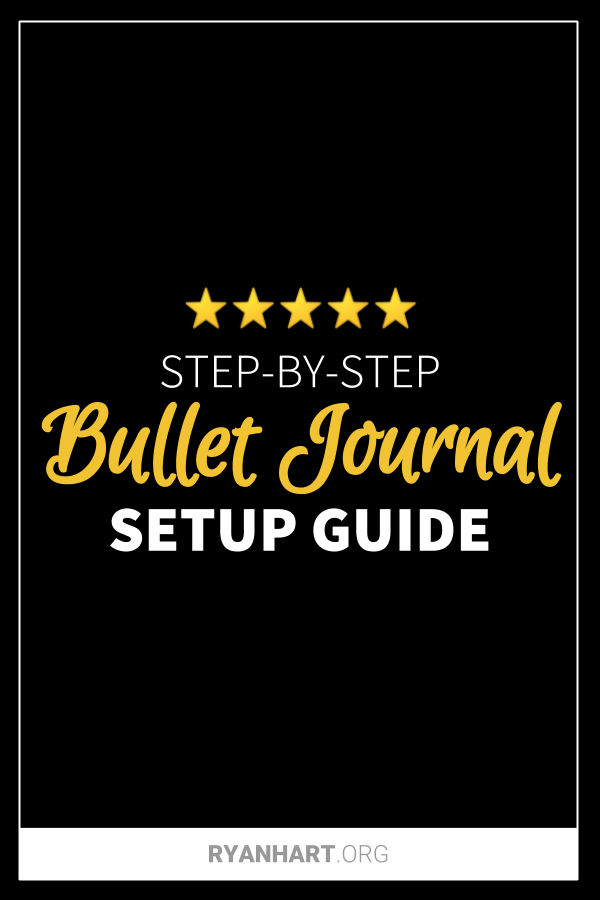The Ultimate Bullet Journal Setup Guide (2019)
by Ryan Hart | Updated on January 21, 2019 | Post may contain affiliate links. As an Amazon Associate we earn from qualifying purchases.
Excited to get your bullet journal setup? Ready to finally get organized and take control of your time?
In this post I’ll show you my monthly Bullet Journal layouts that you can use to get started on the right foot.
Before we continue I want to clarify that the Bullet Journal system is simply a way to keep track of items on your to-do list using bullets or little symbols. That’s it!
All you need is an empty notebook and a pen to get started. You don’t need to be an artist or watercolor master to make Bullet Journaling work for you.
Yes, Bullet Journaling became popular because of the beautiful spreads that have gone viral on Youtube, Pinterest and Instagram. While this attention is great for the Bullet Journaling community, it should not discourage you from getting started if you are not artistic.
Now that we are on the same page about what a Bullet Journal is, let’s get yours setup properly.
In this article I’m going to cover the 6 basic elements of a Bullet Journal. These include:
- Key
- Index
- Future Log
- Monthly Spread
- Collections
- Daily/Weekly Spread
Step 1: Page Numbers
The biggest difference between a bullet journal and a normal weekly planner is that a bullet journal starts as a blank slate. To use the bullet journal system effectively it is important to stay organized and keep track of where calendars and collections are located within your journal. The best way to stay organized is to number every page in your journal. Yes, it may be tedious but it is worth the effort.
There are now journals available that have numbered pages like the popular Leuchtturm1917, which will save you time right from the start.
Step 2: Key or Legend (1 Page)
The Bullet Journal method uses a simple shorthand system to keep track of items on your to-do list. The Key or Legend page will be your reference for what each symbol means throughout your journal. The official Bullet Journal guide gives a few examples, but you can modify your bullets to meet your needs.
Here is a list of the most basic symbols.
You can also modify your bullets with “signifiers.” These indicate special items or notes within your task list. For example, if you add an inspiring idea you may include an exclamation mark rather than a bullet since it is not an immediate action item.
Step 3: Index (2 Pages)
A Bullet Journal is designed to be added to as you go, rather than laid out in advance. That means when you are starting your bullet journal you won’t create 12 layouts for each month.
Instead you will create a layout for this month and a spread for this week, then add more as you go. The logic is that you never know how many pages you’ll need to log your tasks or ideas, so don’t limit yourself upfront.
To keep track of where you monthly spreads and other task lists are located within your journal, you’ll add the topic of the page and page number to the index in the front of your journal. Can’t remember where you wrote down the shopping list for your next home improvement project? Look in the index!
At first you won’t have much to include in your index, but it will grow overtime. Don’t worry that you have 2 blank pages for now.
Step 4: Future Log (4 Pages)
The Future Log is where you can see your entire year at a glance and keep track of tasks that you’ll need to remember… you guessed it… in the FUTURE!
The most common future log layout is to divide each page into 3 horizontal sections. This will give you a total of 12 equal sized boxes divided over 4 pages. Then label each box with the corresponding month and begin to fill in events and due dates within your future log.
I layout my future log with a thumbnail calendar on the left and a list of tasks or events on the right. I find it really helpful to look at the calendar view and a list of tasks all in one place.
Step 5: Monthly Spread (2 pages)
At the beginning of each month you’ll dedicate 2 pages for your monthly spread. The monthly spread is a great way to get a view of your upcoming month and obligations.
I setup my spread with a traditional box-style calendar on the left page and a task list on the right. This layout allows me to see time sensitive items on the calendar and a running list of tasks on the opposite page.
Also, don’t forget to transfer items from your future log to your monthly spread at the beginning of each month.
Step 6: Collections (2+ Pages)
The next step in your bullet journal setup is to leave room for a few collections each month. A collection is a page where you can keep notes on a single topic or jot down ideas.
Some of the most common types of collections include habit trackers, mood trackers, weight loss trackers or bucket lists. There are so many possible ways to use collections that I created a list of 29 bullet journal ideas. Check it out to find some inspiration for your Bullet Journal.
I like to include a few pages for collections after my monthly spread so they stay clumped together. Otherwise they tend to get lost in between the pages of my daily or weekly spreads.
You could also set aside 10 to 20 pages in the back of your bullet journal for your Collections. That would allow you to always know where they are and to make sure they stay up to date.
Step 7: Daily/Weekly Spread (2+ Pages)
Now that we have our bullet journal setup for the month we can start using it to keep track of our daily tasks. The bullet journal system is meant to be used as a continuous log. That means, you will only focus on the tasks for one day at a time. Any other items on your to-do list should be recorded on your future log or monthly task list, then transferred to the appropriate day.
Many bullet journalers like to layout their weekly spreads at the beginning of the month. They simply draw 7 boxes over 2 pages to represent each day of the week. You can try a horizontal or vertical layout to see which works best for you. I personally use a vertical layout because it helps me visualize my week.
Before you lay out all of your weekly spreads keep in mind the downside of this approach. The bullet journal system is designed to give you flexibility to keep track of tasks, journal and doodle without limitations. However, if you setup your weekly spreads in advance this could limit the space you have for your million dollar ideas, reflections or fun stickers.

Conclusion
Getting your bullet journal setup correctly is actually very simple. There are 6 main components to the “bujo” system: key, index, future log, monthly spread, collections, daily spread.
The key to having success with the bullet journal is to keep it simple. If you are not artistic do not stress that your journal is not pretty. The system is designed to keep your life organized and help you get more done.
Sadly I’ve talked to many people that avoid setting up their bullet journal because it looks too time consuming. This couldn’t be further from the truth. In fact, you only need to setup one page at a time.
If you have any questions about my bullet journal setup, don’t hesitate to reach out to me on social media. You can find me on Facebook, Twitter and Instagram.

Ryan Hart is a licensed insurance agent, writer, and former home designer. He is on a mission to help couples protect their homes in retirement with life insurance and annuities.
Want to connect with Ryan? Click here to get his FREE retirement planning newsletter
